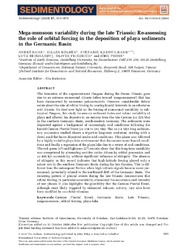Mega-monsoon variability during the late Triassic: Re-assessing the role of orbital forcing in the deposition of playa sediments in the Germanic Basin
DOI: https://doi.org/10.1111/sed.12668
Persistent URL: http://resolver.sub.uni-goettingen.de/purl?gldocs-11858/8846
Persistent URL: http://resolver.sub.uni-goettingen.de/purl?gldocs-11858/8846
Bahr, André; Kolber, Gilles; Kaboth-Bahr, Stefanie; Reinhardt, Lutz; Friedrich, Oliver; Pross, Jörg, 2019: Mega-monsoon variability during the late Triassic: Re-assessing the role of orbital forcing in the deposition of playa sediments in the Germanic Basin. In: Sedimentology, Band 67, 2: 951 - 970, DOI: 10.1111/sed.12668.
 |
Dokument öffnen: |
The formation of the supercontinent Pangaea during the Permo–Triassic gave rise to an extreme monsoonal climate (often termed ‘mega-monsoon’) that has been documented by numerous palaeo-records. However, considerable debate exists about the role of orbital forcing in causing humid intervals in an otherwise arid climate. To shed new light on the forcing of monsoonal variability in subtropical Pangaea, this study focuses on sediment facies and colour variability of playa and alluvial fan deposits in an outcrop from the late Carnian (ca 225 Ma) in the southern Germanic Basin, south-western Germany. The sediments were deposited against a background of increasingly arid conditions following the humid Carnian Pluvial Event (ca 234 to 232 Ma). The ca 2·4 Myr long sedimentary succession studied shows a tripartite long-term evolution, starting with a distal mud-flat facies deposited under arid conditions. This phase was followed by a highly variable playa-lake environment that documents more humid conditions and finally a regression of the playa-lake due to a return of arid conditions. The red–green (a*) and lightness (L*) records show that this long-term variability was overprinted by alternating wet/dry cycles driven by orbital precession and ca 405 kyr eccentricity, without significant influence of obliquity. The absence of obliquity in this record indicates that high-latitude forcing played only a minor role in the southern Germanic Basin during the late Carnian. This is different from the subsequent Norian when high-latitude signals became more pronounced, potentially related to the northward drift of the Germanic Basin. The recurring pattern of pluvial events during the late Triassic demonstrates that orbital forcing, in particular eccentricity, stimulated the occurrence and intensity of wet phases. It also highlights the possibility that the Carnian Pluvial Event, although most likely triggered by enhanced volcanic activity, may also have been modified by an orbital stimulus.
Statistik:
ZugriffsstatistikSammlung:
- Geologie [933]
Schlagworte:
Carnian Pluvial EventGermanic Basin
Late Triassic
mega-monsoon
orbital forcing
playa-lake
This is an open access article under the terms of the Creative Commons Attribution License, which permits use, distribution and reproduction in any medium, provided the original work is properly cited.

